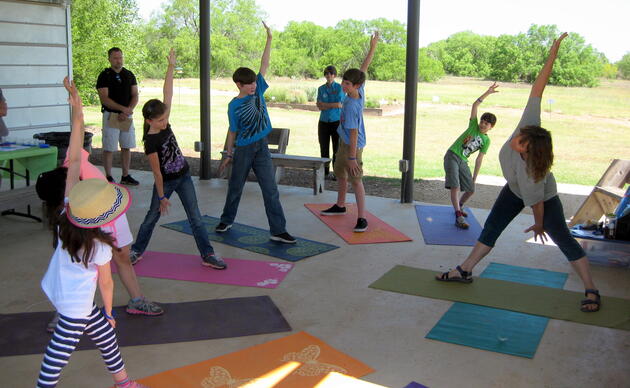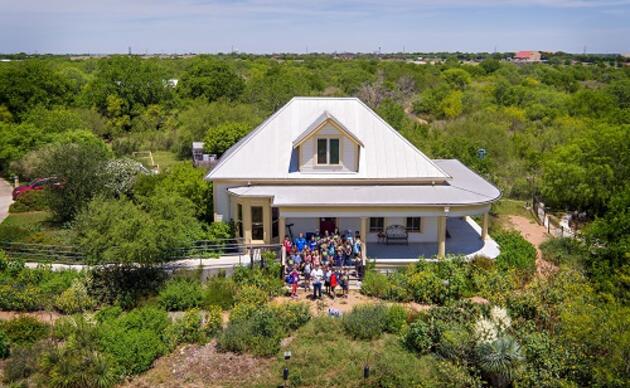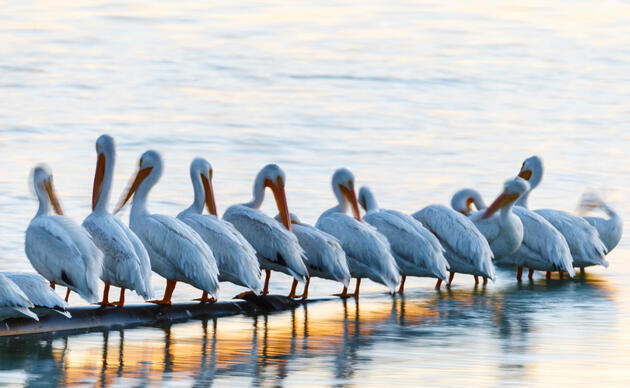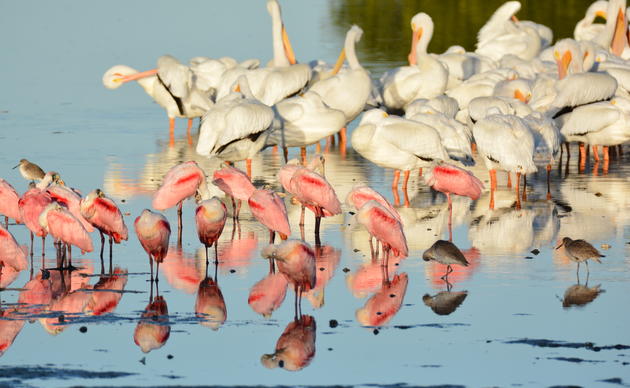General Mitchell Lake Audubon Center Questions
Why are the trails closed?
Usually, we close trails due to weather conditions, including if the trails are wet. Find out why at this link.
What birds will I see at Mitchell Lake Audubon Center? Will I see the endangered Golden-cheeked Warbler?
Although there are historical sightings of the Golden-cheeked Warbler in the area, your best bet is to find them north in the Texas Hill Country. Government Canyon State Natural Area and Eisenhower Park are two places to check.
Depending on the season, Mitchell Lake sees an increase of bird species from August to December and February to May. However, many species are seen year-round, including: Northern Cardinal, Greater Roadrunner, American White Pelican, Crested Caracara, and many more. Always check the list on [ebird] for the most up-to-date sightings.
Can I go boating or kayaking on the lake? Can I swim or fish in the lake?
No. Learn more about the history of water on the south side of San Antonio, including its life as a sewage dump, here.
Can I bring my dog?
No. On occasion, we hold a “Doggy Day” in which our fuzzy friends are allowed to join us. Check our Events page for upcoming opportunities.
Can I ride my bike on the trails?
Not at this time. Bike-riding tends to scare birds, even more than cars. Cars act as a “moving blind”.
Are your trails ADA-compliant?
Yes, a portion of our trails is ADA-compliant. We recommend you give us a call prior to visiting to check those roads are open and available.
Can I drive around? Walk around?
Yes and yes! Many of our trails are available to both walk and/or drive.
Do you rescue or rehab birds?
No, we do not rescue or rehabilitate birds or any other animals. All the birds at Mitchell Lake Audubon Center are naturally occurring and vary by season. If you found a wounded bird, please contact our partners at the Wildlife Rescue and Rehab Center.
Why is Bird Pond dry? Why are the basins/polders dry?
Over the summer, we discovered a blockage in the drainage leading to Bird Pond. As it was nesting season, we were unable to clear the drainage channel safely. As winter approaches, we will close the area to remove debris.
Over the last few months, San Antonio has been in a drought. During this time, we let the ponds naturally evaporate, usually creating the perfect shorebird habitat. We were unable to move water from the lake during this time due to state regulations, resulting in dry ponds. We are working with SAWS, the landowner, to find alternative solutions as waterfowl season approaches. Learn more about the long-term SAWS wetland project at this link.
Ticketing and Membership Questions
Will the change in ticketing system affect how I purchase tickets?
Yes, for the better, we hope! Our new ticketing system will allow you to set up an account as a Member, and access special discounts and perks through our Member portal. For general entry ticket purchases, not much should change, although it will look different when checking out.
How much does it cost to visit?
Admission to the Mitchell Lake Audubon Center is $5 General Admission, $3 Kids, Students, National Audubon Society Members, and those with a Military ID. Admission is FREE for Children under the age of 5 years old. We have a $15 Family Admission good for two adults and any children within the same household.
How do I purchase tickets to Mitchell Lake Audubon Center?
You can purchase tickets ahead of time online, including at the gate, by CLICKING HERE.
Can I purchase tickets after I arrive?
Absolutely. You can either access our online ticketing via QR code upon arrival, or purchase tickets at our ticketing window at the Visitor Center.
What If I purchased tickets, but can't go on the date I reserved?
Please email us at MLAC@audubon.org or call and leave us a voice message at 210.628.1639 no less than 24 hours before your ticket time to reassign the date. We do not offer refunds unless we close the center due to incluemnt weather. This doe NOT include trail closure only.
How do I become a member of Mitchell Lake Audubon Center?
You can purchase a membership to the Mitchell Lake Audubon Center by CLICKING HERE. Membership includes one year of free admission to the center, and special invites to member-only events. With your membership, you also become a member of the National Audubon Society, recieve the award-winning Audubon magazine, and join the Bexar Audubon Society, the locally affliliated Audubon chapter.
What is the difference between a Mitchell Lake Audubon Center, Bexar Audubon Society, San Antonio Audubon Society, and National Audubon Society memberships and organizations?
Mitchell Lake Audubon Center is operated by the National Audubon Society and their staff members. Learn more about Audubon at Audubon.org. The Bexar Audubon Society is the local Audubon-affiliated chapter and is a seperate 501c3 nonprofit from the National Audubon Society. Learn more about the chapter and their organization at bexaraudubon.org. The San Antonio Audubon Society is not affliliated with the National Audubon Society and is a local nonprofit and birding club. Their membership is completely seperate and membership to their organization does not transfer to the Mitchell Lake Audubon Center.
Although seperate nonprofit organizations, the Mitchell Lake Audubon Center, San Antonio Audubon Society, and Bexar Audubon Society often work together locally to better the world for birds.
The name "Audubon" is a proper noun and cannot be copyrighted - many organizations and companies across the country use the "Audubon" name and are not affiliated with the National Audubon Society, nor our mission to protect birds and the places they need.
Bird and Birding General Questions
Where are some other birding hotspots in the San Antonio area?
Check out this great list: http://sanantonioecotourism.com/birdinglocations/
What is the best field guide for the San Antonio area?
As a critical stopover point along the central flyway, we recommend a guide that encompasses all of North America. If looking between western or eastern guides, we recommend eastern for birding in Texas. Some of our favorites are: Sibley’s Birds of North America, Kaufman Field Guide to Birds of North America, Peterson Field Guide to Birds of North America. Try second-hand bookstores to find the best deal.
Do you have a recommendation for wildlife-viewing scopes?
The National Audubon Society put together a guide to buying a spotting scope. The guide breaks down suggestions by price-range. https://www.audubon.org/gear/scope-guide
Do you have a recommendation for binoculars?
The National Audubon Society put together a guide to buying binoculars. The guide breaks down suggestions by price-range. https://www.audubon.org/gear/binocular-guide
If a bird species is not Threatened or Endangered, is it still protected under any laws?
Yes! All native bird species in the United States are protected by federal law under the Migratory Bird Treaty Act of 1918. Moreover, the nest of any native bird species is also protected under this law. It is illegal to "pursue, hunt, take, capture, kill, attempt to take, capture or kill, possess... at any time, or in any manner, any migratory bird, included in the terms of this Convention... or any part, nest, or egg of any such bird."
In other words, disturbing or destroying nests when they are occupied is illegal unless someone has obtained a permit from US Fish and Wildlife Service. If you have a nuisance nest you would like to address, you must wait until the nest has been vacated before removing it. The best way to prevent a reoccurrence of the issue is to exclude or discourage nesting in that location before the birds return the following spring. In the event of a serious problem like a nuisance rookery in a residential area, affected individuals should contact the US Fish and Wildlife Service, who can assess the situation and determine a course of action.
The only exceptions under this law are a handful of exotic species such as the House Sparrow, European Starling, Rock Pigeon, or Eurasian Collared-Dove.
I found a baby bird on the ground what do I do with it?
While your first instinct may be to scoop up a seemingly helpless baby bird, the best course of action is to assess the situation before interfering. Unsure about the difference between hatchlings, nestlings, and fledglings?
Hatchling: Birds have just hatched and are naked with closed eyes. These birds must either be returned to the nest if possible, or taken to a rehabilitator for care.
Nestling: Birds have some feathers and their eyes are now open. They usually lack the ability to grip a branch or finger with their feet and do not have developed wing feathers that will allow them to fly. These birds must be returned to the nest if possible, or taken to a rehabilitator for care.
Fledgling: Ready to leave the nest! Birds have most of their feathers and are able to grip a branch or finger with their feet. Their wing feathers are developed enough to allow them to fly. If the bird is not in immediate danger, leave it be. Keep cats and dogs inside and let the parent birds care for the young bird.
I saw a bird but I have no idea what it is. Can you help me identify it?
We’ll be happy to help! If you have a photo, or just a description, please e-mail it to MLAC@audubon.org with “Bird ID Question” in the subject line.
I feed birds in my back yard, but now there is a hawk hunting them! How do I deal with this/get rid of the hawk?
In natural settings, some hawks like Cooper’s Hawks and Sharp-shinned Hawks prey on smaller birds. While it’s unfortunate that the birds visiting your feeder now have to keep an eye out for a hungry hawk, there are things you can do to give the little birds some help while still being able to enjoy your bird of prey visitor.
The best thing you can do is to introduce safe shelter into your yard. Dense shrubs make an excellent escape for songbirds trying to hide from hawks and other predators. If you have downed tree limbs, creating a brush piles can offer shelter, as can an old Christmas tree during the winter.
You may also notice that the hawks are scaring some of the smaller birds from your feeders into your windows. If this is the case, try either moving your feeders to within 3 feet of your windows or more than 30 feet away to reduce the risk of window collisions.
I have this crazy red bird that keeps attacking my window. What’s going on and how do I make it stop?
You have a very excited Northern Cardinal that is attacking a pesky rival who just won’t go away (its own reflection in the window). While it can be annoying, the bird is unlikely to hurt itself. The best way to get to fix this is to modify your problem window to break up the reflection so the bird stops seeing itself.
Window decals can be helpful, as can any number of treatments (screens, solar shades, window films) that break up the bird’s reflection in the surface of the glass.
Birds keep crashing into my windows. What can I do to fix it?
Collision with building glass is the #2 human-related cause of death to birds in the United States, killing hundreds of millions of birds. Most collisions are due to the birds’ inability to perceive that there is glass present in their flightpath. Up to 44% of these collisions happen on residential structures, with another 56% on low-rise buildings.
Some factors to consider:
- Feeder placement. Locating your birdfeeders either very close to windows (within 3 feet) or far from windows (more than 30 feet away) can reduce the likelihood of feeder-visiting birds colliding with your glass.
- Landscaping. Vegetation reflected in windows can attract birds, which may not realize they are flying towards a reflection rather than a safe habitat area. Birds may try to fly to landscaping that is behind glass, such as plants in an atrium or lobby. Try to place new trees and shrubs that may pose a reflection problem less than 3 feet from glass. Alternately, adjust the reflectivity of the glass using surface treatments or shading.
- New windows. As homeowners replace old windows with newer, more efficient ones, previously harmless windows may become new collision problems. When replacing windows, homeowners should ask installers about options for external screens and other treatments that could help resolve collision issues should they arise. Be sure to ask about anything that might void a warranty on new windows.
Solutions
Anything that makes glass more visible to birds can help reduce window collisions. There are a variety of options available to suit most windows, including:
- Decals or Bird Tape—follow 2 x 4 Rule
- Exterior window screens and solar shades
- Colorful or semi-transparent window films
- Etched or frosted glass
- Fine-gauge bird netting (used to keep birds off fruit trees)
- Keeping blinds lowered (open or shut)
Learn more about how Audubon and its partners are working to make buildings safer for birds.
What should I feed to the ducks/geese in the pond near my house?
You should not feed wild ducks or geese anything! Unlike hanging feeders for birds in your backyard, feeding waterfowl can lead to a variety of issues both for the birds and for people.
- Feeding waterfowl can lead to malnourished birds. Ducks and geese are omnivores, and they need a balanced diet of aquatic plants, tree nuts, grass seeds, insects, and crustaceans. Bread, crackers, popcorn, cereal and other human food is not healthy for our wild waterfowl. They can become malnourished or ill even if they look healthy. Many birds suffer liver and heart disease and bread can become impacted in their crops. Young birds are especially susceptible to crippling conditions such as angel wing, splay leg, and developmental issues related to poor nutrition.
- Feeding waterfowl can result in overpopulation, habitat degradation, and encourage the spread of diseases. Regular feeding of waterfowl can result in unusually large and dense congregations of birds, making disease transmission more likely. This type of situation can increase the risk of disease transmission between birds. High concentrations of waterfowl can severely degrade habitats and waterways, putting extra stress on already sensitive areas.
- Feeding of waterfowl can interfere with their natural behaviors. Most species of North American ducks and geese are migratory, and feeding can interfere with their migratory instinct. They can become resident in large numbers, often leading to overpopulation in parks and ponds, conditions that favor increased aggression between birds. Moreover, many of these birds, especially geese, can become acclimated to and aggressive towards humans, and may become a nuisance requiring control measures.
The best way to appreciate ducks and geese is to enjoy their natural behaviors. Different species prefer different types of plant and animal foods, and much of the fun of watching them is appreciating the diverse niches they occupy in the wetland ecosystem.
How you can help, right now
Become a Member
Enjoy free admission, discounts in our nature store, and free and discounted programs.




